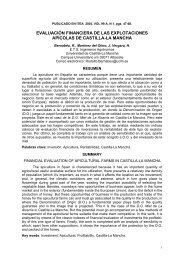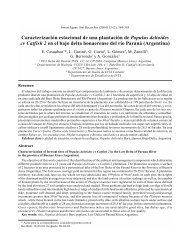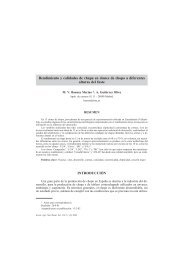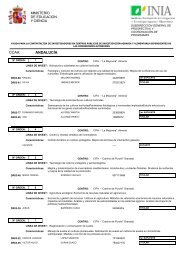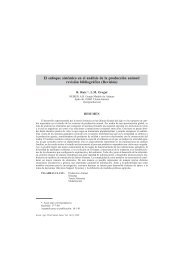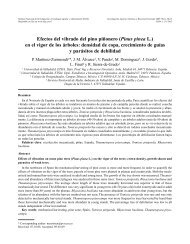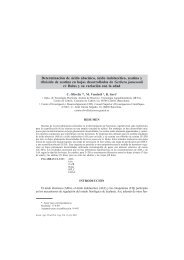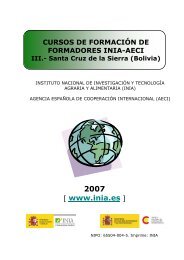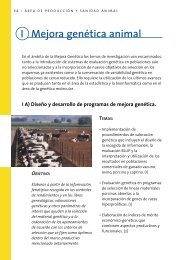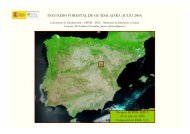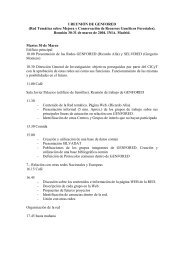Status of medicinal and aromatic plants in - Inia
Status of medicinal and aromatic plants in - Inia
Status of medicinal and aromatic plants in - Inia
You also want an ePaper? Increase the reach of your titles
YUMPU automatically turns print PDFs into web optimized ePapers that Google loves.
148<br />
WORKING GROUP ON MEDICINAL AND AROMATIC PLANTS: FIRST MEETING<br />
Table 1. Accessions <strong>of</strong> O. vulgare L. <strong>in</strong>cluded <strong>in</strong> the study<br />
Population No. <strong>of</strong> <strong>plants</strong> Subtaxa Orig<strong>in</strong><br />
9 2 O. vulgare L. subsp. vulgare ORI 15/91, Georgia<br />
9/1 2 O. vulgare L. subsp. hirtum (L<strong>in</strong>k) Ietswaart Greece<br />
9/3 4 O. vulgare L. subsp. vulgare Jesenice<br />
9/4 5 O. vulgare L. subsp. vulgare Žirovniška plan<strong>in</strong>a<br />
9/6 4 O. vulgare L. subsp. vulgare Stari vrh nad Šk<strong>of</strong>jo Loko<br />
9/7 4 O. vulgare L. subsp. vulgare Završnica<br />
9/8 5 O. vulgare L. subsp. vulgare Mežakla<br />
9/9 5 O. vulgare L. subsp. vulgare Nanos, Lijak<br />
9/11 3 O. vulgare L. subsp. vulgare Slovenske Konjice<br />
9/12 5 O. vulgare L. subsp. vulgare Blato<br />
9/14 5 O. vulgare L. subsp. vulgare Štampetov most, Vrhnika<br />
For the isolation <strong>of</strong> DNA, different types <strong>of</strong> plant material (fresh, frozen, young, old,<br />
lyophilized leaves, leaves dried at 40°C, <strong>plants</strong> grown <strong>in</strong> vitro) were taken <strong>and</strong> different<br />
protocols were tested: two modified CTAB protocols (Šuštar-Vozlič <strong>and</strong> Javornik 1999;<br />
Z. Liber, personal communication 2000), SDS protocol (Beye <strong>and</strong> Raeder 1993) <strong>and</strong> a<br />
commercial kit (Dneasy Plant M<strong>in</strong>i Kit, Qiagen).<br />
PCR amplifications were carried out <strong>in</strong> 25 µl mixture with DNA content <strong>and</strong> Mg 2+<br />
concentrations be<strong>in</strong>g optimized. Different types <strong>of</strong> Taq DNA polymerases were also tested.<br />
Twenty-five arbitrary 10-mer primers (Operon Technologies) were applied.<br />
A prelim<strong>in</strong>ary study <strong>of</strong> genetic variability us<strong>in</strong>g RAPD molecular markers was made. For<br />
data analysis <strong>and</strong> the construction <strong>of</strong> a dendrogram, NTSYS-pc s<strong>of</strong>tware was used (Rohlf<br />
1993). UPGMA cluster was performed us<strong>in</strong>g the RAPD data.<br />
Results <strong>and</strong> discussion<br />
Various types <strong>of</strong> plant material <strong>and</strong> a number <strong>of</strong> different protocols for the isolation <strong>of</strong> DNA<br />
were tested <strong>in</strong> order to obta<strong>in</strong> good quality DNA for PCR reactions. When fresh or frozen<br />
leaves <strong>of</strong> O. vulgare subsp. vulgare collected <strong>in</strong> autumn were used for the isolation <strong>of</strong> DNA,<br />
no positive result <strong>in</strong> PCR reaction was obta<strong>in</strong>ed regardless <strong>of</strong> the isolation protocol be<strong>in</strong>g<br />
used. This was probably due to the accumulation <strong>of</strong> large amounts <strong>of</strong> secondary metabolites<br />
<strong>in</strong> old plant material, as previously reported (Khanuja et al. 1999). DNA purified with<br />
DNeasy Plant M<strong>in</strong>i Kit (Qiagen) from <strong>plants</strong> grown <strong>in</strong> vitro gave the best results <strong>in</strong> PCR<br />
reactions. A positive PCR reaction was also obta<strong>in</strong>ed when DNA was isolated from leaves<br />
taken from the greenhouse or dried at 40°C. It was found out that the age <strong>and</strong> quality <strong>of</strong><br />
plant material were <strong>of</strong> major importance for a successful PCR amplification. The results <strong>of</strong><br />
PCR reactions with different types <strong>of</strong> plant material used <strong>and</strong> different isolation protocols<br />
applied are presented <strong>in</strong> Table 2.<br />
Because <strong>of</strong> a limited number <strong>of</strong> samples from <strong>in</strong>dividual populations <strong>and</strong> a small number<br />
<strong>of</strong> polymorphic RAPD pr<strong>of</strong>iles generated after electrophoresis <strong>of</strong> PCR products, the results <strong>of</strong><br />
statistical analysis showed that samples belong<strong>in</strong>g to the same populations, as well as<br />
outgroups on the dendrogram, did not usually cluster together.<br />
In the present study a protocol for DNA isolation was developed <strong>and</strong> PCR reactions were<br />
optimized. In further <strong>in</strong>vestigations, genetic analysis will be performed on a larger number<br />
<strong>of</strong> samples from each population <strong>of</strong> O. vulgare subsp. vulgare, <strong>and</strong> possible correlations<br />
between genetic variability, morphological <strong>and</strong> biochemical properties will be assessed.




